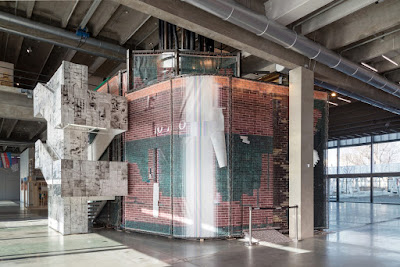First established by Dasha Zhukova in 2008, the iconic Garage
Museum of Contemporary Art has since been re-designed
by Rem Koolhaas in Gorky Park, Moscow. As described by their curatorial team, ‘the Museum’s
extensive program of exhibitions, events, education, research, and
publishing reflects current developments in Russian and international
culture.’
We’ve all frequented the leading spaces for contemporary art such as
Centre Pompidou in Paris, Tate Modern in London or perhaps MoMa in New York,
but forward-thinking Garage have finally turned our attention to Moscow. With five
exhibitions, a renowned magazine, cutting-edge book shop, and open-air cinema, Garage
has evolved into a creative hub like no other.
Re-purposing the 1968 Vremena Goda (Seasons
of the Year) Soviet Modernist restaurant, the unique space has always been a
gathering place. Inevitably, their café now overflows with artists, curators and
art lovers. Although, it’s transformative re-design is ultra-modern, they’ve
also restored the original mosaics, celebrating soviet interiors with the iconic allegory of autumn.
Given that Garage was first opened in a bus depot, the
architecture continues to reflect the ephemeral architecture
of Moscow – a city always under construction. The notable atrium commission is
Irina Korina’s three-story architectural intervention The Tail Wags the Comet, which launched in Spring during the acclaimed
Garage Triennial of Russian Contemporary Art.
Korina’s multi-sensory installation captures the
schizophrenic architecture of Moscow. She uses the sounds and smells of Moscow
as vehicles of memory from rubber to cut grass and sugary cookies. Korina is an artist whose
creations consistently embrace the art historical notion of Gesamtkunstwerk. As
with The Tail Wags the Comet, each
piece is always a total work of art combining architecture, sculptural
elements. The ceiling also reflects Islamic architecture.
Guided by the young curator Iaroslav Volovod, we were also shown the American
artist Raymond Pettiboyn’s playful Cloud
of Misreading exhibition. It included a broad spectrum of ephemera, paper works and various texts
from the Punk scene through to contemporary culture. Questioning the
significance of materials was the Congo
Art Works: Popular Painting exhibition, within which flour bags were often used
as canvases alongside other murals, paintings and artefacts.
After a quick look at David
Adjaye: Form, Heft, Material - a survey of the famous architect’s career - we found
ourselves swept into the café for a matcha latte and time to reflect on our experience. With five
exhibitions in the space, we were happy to have got through at least four. As
observed by our photographer, Garage museum’s current exhibitions all felt so
immersive that, “we had challenged our senses of sight, sound, smell all before arriving
for a piece of cake in the cafe."
After only a few days of studio visits and gallery tours in
Moscow, I would urge all writers, collectors and art lovers to bypass their
usual citybreaks to Paris or Berlin in favour of this art scene. Although Moscow can often painted as
a dark or oppressive place by the popular media, I would instead describe the city as a truly magical place. Our guide Iaroslav’s frequent (mis) use of the word ‘fairytale’ to
loosely describe anything fictional captured this mood perfectly.
Written by Flora Alexandra Ogilvy, founder of Arteviste.






No comments:
Post a Comment